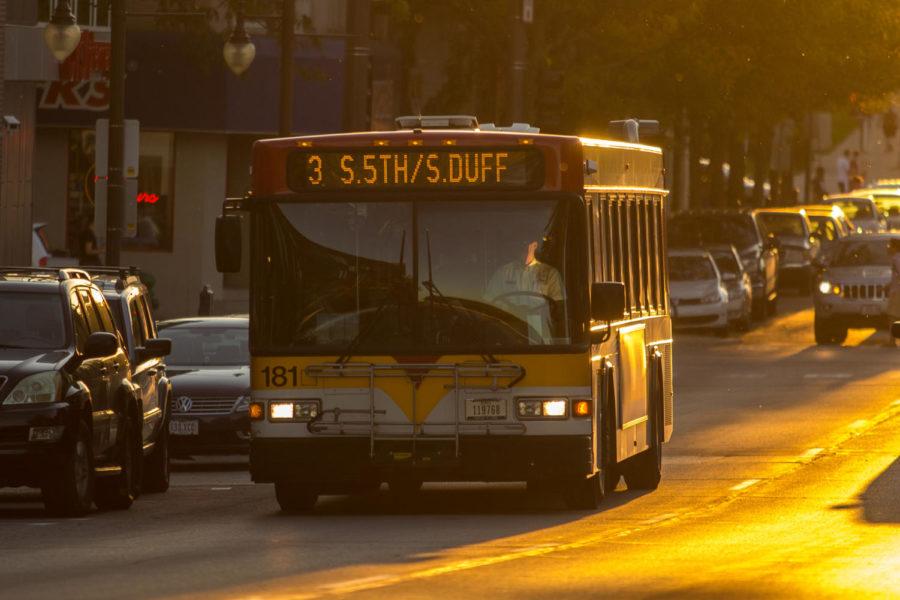Months after bus overhaul, students note customer dissatisfaction
A CyRide blue line bus travels eastward on Lincoln Way at sunset Sept. 18, 2016. CyRide recently received federal grant funding to purchase electric buses and infrastructure to support them.
February 7, 2019
CyRide. The single word can cause a mix of emotions for anyone who uses the transit system throughout the city of Ames and Iowa State’s campus.
In a statement released at the beginning of February, the city of Ames and CyRide announced numerous changes to a number of its well-known routes.
The inspiration behind these changes was driven by input received by riders who were mostly not satisfied with the changes made in CyRide 2.0.
Of the 492 respondents to the survey, 421 people — nearly 86 percent — disagreed with the statement “I am satisfied with the current transit service CyRide offers under CyRide 2.0 and no changes are needed.”
CyRide Director Sheri Kyras saw these results and decided to work toward improvements to the current system.
“Customer satisfaction,” Kyras said when asked what her number one priority is. “We want people to like the service, we want them to feel like it’s easy to use the service, can get around and move around the community as they need to.”
The most common request by students within the survey was to increase the frequency of service of certain routes or to expand the areas other routes cover, something that “would increase expenses” according to the survey report.
The recommendation CyRide made following the report, for example, would constitute a net $176,672 increase over last years budget.
Kyras said user feedback was an important part of the changes they have been working toward. Especially the negative feedback, which is crucial to those who run CyRide. It not only helps them create the change for a new system, but it tells them what specific changes need to be made.
“If I could change anything about CyRide, I would want a bus that could take me from the MWL area to Freddy Court without needing to change busses,” said Sam Peterson, a freshman in mathematics.
While CyRide can’t cater to every specific need for every single student, they try to meet needs based off of data collected by researchers who went on the routes themselves.
According to one of CyRide’s reports and the recent survey, there has been a slight reduction in overall ridership, in part due to lower enrollment numbers at Iowa State. Most notably, west Ames routes reduced in ridership by 14 percent or 300,000 riders compared to last year, while the 23 Orange route increased by nearly 100,000 riders or 1.2 percent.
“It’s OK,” said Reed Duncan, a sophomore majoring in pre-business. “It’s usually late and the routes can be a little confusing.”
For more massive changes that CyRide goes under, such as the transformation and addition of several routes, otherwise known as CyRide 2.0, they brought in outsiders to help make the original changes.
“We hired a national consultant who does a lot of system redesigns, to take a look at our whole system,” Kyras said. “They gathered up a lot of data. We had good data on where we had a lot of ridership and low ridership, so we could kind of reorient the service and try and match the demand with the service level we were providing in that area. And that turned into CyRide 2.0.”
While CyRide won’t be receiving a major transformation this year, some route changes will begin as soon as May, with even more routes changing in August. Routes impacted are as follows: #9 Plum, #14 Peach and #25 Gold, all happening in May. The routes changing towards the beginning of the 2019-2020 school year are #6 Brown, #11 Cherry, #12 Lilac and #25 Gold.
“I think CyRide is a very convenient option for ISU student transportation,” said Andrew Schon, a sophomore in elementary education. “I use 23 Orange the most because it’s easy to get around central campus.”
A common theme with all of the changes within the routes is extended time periods and the timeliness of busses. For example, CyRide is implementing early morning trips, which makes commuting in the mornings more convenient.
“It’s basically the same route structure, we just kept adding busses as the demand required it,” Kyras said. The constant demand for busses was due in part by new additions to the city of Ames, such as apartment complexes.
The inspiration and main driving force behind CyRide 2.0 and the new route changes is wanting to grow right alongside the university as it continues to grow, reaching more students and residents of Ames at the same time.
“You never quite know how people are going to use the system,” Kyras said. So that’s why we began gathering feedback over the summer and fall semester for how it was working for people on each route, which things would they like to see differently.”







